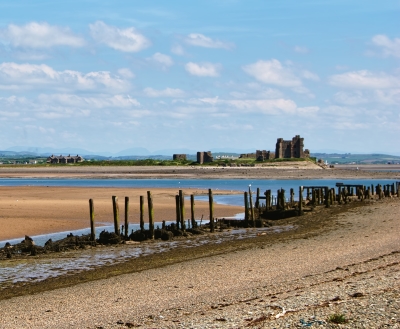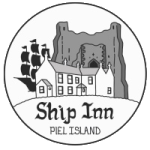Piel Island and Castle
 Piel Island has a long and interesting history and is of considerable importance in the local area both because of its links to Furness Abbey and a major deep water harbour. There is evidence of human occupation spanning at least the last 3000 years. Piel Island was probably visited by the Celts and later by the Romans during their conquest of Britain. The first recorded name of the island, Foudray, came from the Scandinavian settlers to the area. The name Foudray or Fotheray comes from the Old Norse for fire island – meaning a fire beacon to guide boats. Foundray may have been used as a foddering place for the settlers’ grazing animals.
Piel Island has a long and interesting history and is of considerable importance in the local area both because of its links to Furness Abbey and a major deep water harbour. There is evidence of human occupation spanning at least the last 3000 years. Piel Island was probably visited by the Celts and later by the Romans during their conquest of Britain. The first recorded name of the island, Foudray, came from the Scandinavian settlers to the area. The name Foudray or Fotheray comes from the Old Norse for fire island – meaning a fire beacon to guide boats. Foundray may have been used as a foddering place for the settlers’ grazing animals.In 1127 the island was given to the Savignac monks as part of their original land for an abbey from King Stephen to the Abbot of Savigny in Normandy. By order of the Abbot, Furness Abbey became Cistercian in 1148. Furness Abbey started to grow and Foudray fulfilled their need for a safe harbour. In 1212 King John granted the Abbey a licence to land one cargo of “wheat, flour and other provisions” in order to stave off a famine caused by the failure of the local harvest. It is likely that some form of structure existed to house cargos entering the port especially as the trade from Piel to Abbey lands in Ireland increased during the 13th Century. The “Port of Furness” was by this time well established and the trade in corn considerable. In 1327 Furness Abbey was granted the right to crenellate “fortify” its existing dwelling house.
The current motte and bailey “castle” with its defence ditches was built in the early part of the 14th century. It was probably intended to be used as a fortified warehouse to keep cargoes safe from pirates and other raiders. The Abbey soon discovered that it did not just keep the pirates out, the “Pile of Fotheray” (as it became known from medieval times) it also kept the King’s customs men at a distance. It is widely known at the time that the Abbey was active in the smuggling business when in 1423 a petition from the merchants in Calais was issued complaining that Furness Abbey had been smuggling wool from Piel without paying the necessary dues. Six years later, due to the threat of invasion, the castle was partially rebuilt and new arrangements were made for its defence with each tenant of the Abbey required to supply men and arms.
Piel’s notoriety during the 15th Century continued when Colonel Martin Swartz and his German mercenaries landed on the island on June 4th 1487 as part of an attempt by Lambert Simnel to seize the English Crown. Simnel claimed that he was the Earl of Warwick and therefore was the rightful King of England. Simnel set off across Furness for London. He was defeated by the King’s forces as the Battle of Stoke on June 16th and when he did finally arrive in London it was as a prisoner of Henry VII.
Following the restoration of Charles II, the Lordship of Furness was given to the newly ennobled Duke of Albemarle in 1662 and this included the castle and part of the remaining land on the island. After this date activity on Piel seems to have revolved around shipping and industry. A salt works is recorded as existing on the island from as early as 1662 and in 1667 a proposal was made to use Piel as a ship yard with the intention of constructing three third rate frigates by 1st August 1671. There is also a suggestion that a ship’s chandlery existed on the island in the 17th Century.
During the late 17th and 18th century Piel became important due to its collection of customs. A customs officer worked from Piel from 1669 and during the early 18th century several seizures of illegally imported alcohol were made. Officers working at Piel still had no permanent base and were required to travel from Lancaster.
In the early 19th century Piel remained important for shipping entering the harbour and was occupied by a number of pilots appointed by the Port Commissioners of Lancaster. They were granted an old barn to be converted into cottages and land by the Duke of Buccleuch. There were several disputes over access to land and water with the landlord of the Ship Inn. In 1875 a row of cottages was constructed for pilots to the north west of the inn.
Until 1874 the ownership of the island was divided between the Duke of Buccleuch who owned the castle and the Ship Inn and a Mr C W Archibald who owned the rest. The Duke purchased the remainder of the land in 1874 and spent a considerable sum on maintenance to the crumbling castle. In 1919 the Duke decided to sell the entire island and a prospectus was drawn up. The intervention of the mayor of Barrow, Alfred Barrow in August 1919 with a request that the island be given to the town halted the sale. The entire island was given over to the town of Barrow-in-Furness in 1920 as a memorial to those who lost their lives during the First World War. The guardianship of the castle was transferred to the Secretary of State for the Environment in 1973 from whom it passed to English Heritage.
Source Barrow Borough Council
